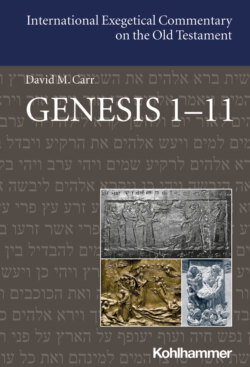Читать книгу Genesis 1-11 - David M. Carr - Страница 22
На сайте Литреса книга снята с продажи.
Separate Precursors to Gen 1:1–2:3: The Enuma Elish Epic and Psalm 104
ОглавлениеGenesis 1 also relates to several traditions outside of the book of Genesis. In particular, Gen 1 seems to relate to and contrast with the Enuma Elish epic, a second millennium text that later became one of the most often cited and commented-on compositions in the Babylonian corpus.24 This text eclectically draws on multiple Mesopotamian traditions to establish the supremacy of Marduk and his temple in Babylon.25 After an initial description of the triumph of Marduk’s father over the sweet-water god, Apsu, the epic turns to detail Marduk’s similar triumph over Tiamat, a female dragon representing the primeval ocean. The gods then proclaim him king (IV: 14, 28), and he further demonstrates his absolute power by making constellations of stars appear and disappear at his command (IV:19–26). After the gods reaffirm his absolute kingship (V:109–110, 131–36, 151–2), Marduk then further demonstrates his power through his following acts of creation: using the upper half of Tiamat’s carcass as a barrier to keep the upper ocean from merging with the lower one (IV:137–138), creating the astral bodies to mark calendar days and give divinatory signs (V:1–41), and reorganizing Tiamat’s watery body into the clouds along with the Tigris and Euphrates rivers that were so important to Mesopotamian civilization (V:48–62). The epic’s description of creation concludes by adapting older Mesopotamian traditions about the creation of humanity, now having Marduk prompt Ea to create humans so that the gods can rest, which they eventually do in Marduk’s own Esagila temple (VI:2–66).26 This creation section is followed by yet more reaffirmations of Marduk’s kingship in the council of the gods (VI:95–120) and in the epic’s concluding list of fifty names for him (VI:121–166).
Though Gen 1 never once uses the word “king” for God, it echoes the Enuma Elish epic in its use of a creation account to demonstrate the absolute supremacy of ‘God’. God now creates every element of the cosmos by decree (cf. Enuma Elish IV:19–26). There is no Tiamat-like opposition to this God’s supremacy, and we only see faint echoes of this motif in a fleeting reference to God’s creation of sea monsters (תנינם Gen 1:21) and possibly the choice of the Hebrew word תהום to refer to the primeval ocean (1:2).27 With such divine opponents out of the picture, the demonstration of God’s power in Gen 1 comes exclusively through God’s creation of a cosmos crowned by humans, a creation description whose major components parallel those in the Enuma Elish epic—the creation of a heavenly roof to separate upper ocean from lower (Gen 1:6–8; cf. Enuma Elish IV:137–38), the making of astral bodies for marking time and signs (Gen 1:14–18; cf. V:1–41), the organization of world waters (Gen 1:9–10; cf. V:48–62); and a climactic focus on the creation of humans in the wake of a process of divine consultation (Gen 1:26–27; cf. VI:1–33).28 Along the way, certain elements in the Gen 1 creation account, such as its echo of the Enuma Elish epic’s idea of stars as useful for divination (“for signs” לאתת Gen 1:14), seem to be blind motifs derived from its Mesopotamian precursor text.
Finally, though less clear, it is likely that Gen 1 draws as well on Psalm 104, and—by way of Psalm 104—possibly on Egyptian and/or Canaanite hymnic traditions, such as the famous Egyptian Hymn to the Aten.29 Scholars have long observed numerous parallels between the first part of Gen 1 and Psalm 104, earth initially covered by a primeval ocean (again תהום Ps 104:6; Gen 1:2), God’s wind and light at the outset of creation (Ps 104:2, 4), God’s spreading out the heavens (Ps 104:2b; Gen 1:6–8), gathering the waters (Ps 104:7–9; Gen 1:9–10), providing food from the earth (Ps 104:10–18; Gen 1:11–12), creating heavenly bodies to mark time (Ps 104:19–23; Gen 1:14–18), and forming the sea and its creatures (Ps 104:25–26; Gen 1:20–21).30 Though the different wording and genre of the texts makes a precise determination of their relationship difficult, the extent of their parallels seems to indicate some kind of particular connection. Moreover, if they are genetically related to each other, it is easier to see how the author of Gen 1 might expand the praise of creation in Psalm 104, than it is to see the author of the Psalm 104 hymn as only praising the less theologically central parts of the Gen 1 creation.31
